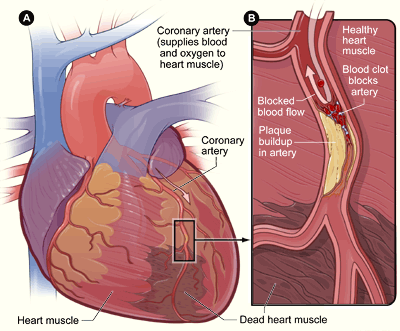Atherosclerotic plaque
Atherosclerotic Plaque is a medical condition characterized by the accumulation of fatty deposits, cholesterol, calcium, and other substances in the inner lining of an artery. This build-up is known as plaque and can lead to serious health complications such as heart disease and stroke.
Overview[edit | edit source]
Atherosclerotic plaque is a key component of atherosclerosis, a progressive disease that can affect arteries throughout the body. The plaque forms when certain substances circulating in the blood, such as cholesterol, fatty compounds, calcium, and cellular waste products, accumulate on the inner walls of the arteries. This process can begin in early adulthood and progress throughout a person's life.
Pathophysiology[edit | edit source]
The formation of atherosclerotic plaque is a complex process that involves multiple stages. Initially, damage or injury to the inner lining of an artery, often caused by factors such as high blood pressure, smoking, or high levels of cholesterol in the blood, triggers an inflammatory response. This leads to the accumulation of lipoproteins in the arterial wall, which then oxidize and trigger further inflammation. Over time, this process leads to the formation of a fibrous cap over the accumulated substances, creating a stable atherosclerotic plaque.
Clinical Significance[edit | edit source]
Atherosclerotic plaques can cause a range of health problems depending on their location. In the coronary arteries, plaque build-up can lead to coronary artery disease, which can cause chest pain (angina) and heart attacks. In the carotid arteries in the neck, plaques can cause carotid artery disease, which can lead to stroke. Plaques in the peripheral arteries can cause peripheral artery disease, leading to pain and reduced mobility.
Treatment[edit | edit source]
Treatment for atherosclerotic plaque involves lifestyle changes, medication, and in some cases, surgery. Lifestyle changes can include quitting smoking, eating a healthy diet, and getting regular exercise. Medications can help control blood pressure, cholesterol levels, and other risk factors. In severe cases, procedures such as angioplasty or bypass surgery may be necessary to improve blood flow.
See Also[edit | edit source]
Translate: - East Asian
中文,
日本,
한국어,
South Asian
हिन्दी,
தமிழ்,
తెలుగు,
Urdu,
ಕನ್ನಡ,
Southeast Asian
Indonesian,
Vietnamese,
Thai,
မြန်မာဘာသာ,
বাংলা
European
español,
Deutsch,
français,
Greek,
português do Brasil,
polski,
română,
русский,
Nederlands,
norsk,
svenska,
suomi,
Italian
Middle Eastern & African
عربى,
Turkish,
Persian,
Hebrew,
Afrikaans,
isiZulu,
Kiswahili,
Other
Bulgarian,
Hungarian,
Czech,
Swedish,
മലയാളം,
मराठी,
ਪੰਜਾਬੀ,
ગુજરાતી,
Portuguese,
Ukrainian
Navigation: Wellness - Encyclopedia - Health topics - Disease Index - Drugs - World Directory - Gray's Anatomy - Keto diet - Recipes
Search WikiMD
Ad.Tired of being Overweight? Try W8MD's physician weight loss program.
Semaglutide (Ozempic / Wegovy and Tirzepatide (Mounjaro) available.
Advertise on WikiMD
WikiMD is not a substitute for professional medical advice. See full disclaimer.
Credits:Most images are courtesy of Wikimedia commons, and templates Wikipedia, licensed under CC BY SA or similar.Contributors: Admin, Prab R. Tumpati, MD




